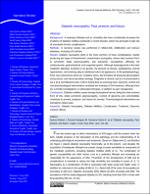| dc.contributor.author | Quiroz-Aldave, Juan | |
| dc.contributor.author | Durand-Vásquez, María | |
| dc.contributor.author | Gamarra Osorio, Elman Rolando | |
| dc.contributor.author | Suarez-Rojas, Jacsel | |
| dc.contributor.author | Jantine Roseboom, Pela | |
| dc.contributor.author | Alcalá-Mendoza, Rosa | |
| dc.contributor.author | Coronado-Arroyo, Julia | |
| dc.contributor.author | Zavaleta-Gutiérrez, Francisca | |
| dc.contributor.author | Concepción-Urteaga, Luis | |
| dc.contributor.author | Concepción Zavaleta, Marcio José | |
| dc.date.accessioned | 2023-12-14T15:44:39Z | |
| dc.date.available | 2023-12-14T15:44:39Z | |
| dc.date.issued | 2023-09-06 | |
| dc.identifier.citation | Caspian Journal of Internal Medicine 2023; 14(2). | es_PE |
| dc.identifier.uri | https://hdl.handle.net/20.500.12959/4707 | |
| dc.description.abstract | Background: A sedentary lifestyle and an unhealthy diet have considerably increased the
incidence of diabetes mellitus worldwide in recent decades, which has generated a high rate
of associated chronic complications.
Methods: A narrative review was performed in MEDLINE, EMBASES and SciELO
databases, including 162 articles.
Results: Diabetic neuropathy (DN) is the most common of these complications, mainly
producing two types of involvement: sensorimotor neuropathy, whose most common form
is symmetric distal polyneuropathy, and autonomic neuropathies, affecting the
cardiovascular, gastrointestinal, and urogenital system. Although hyperglycemia is the main
metabolic alteration involved in its genesis, the presents of obesity, dyslipidemia, arterial
hypertension, and smoking, play an additional role in its appearance. In the pathophysiology,
three main phenomena stand out: oxidative stress, the formation of advanced glycosylation
end-products, and microvasculature damage. Diagnosis is clinical, and it is recommended to
use a 10 g monofilament and a 128 Hz tuning fork as screening tools. Glycemic control and
non-pharmacological interventions constitute the mainstay of DN treatment, although there
are currently investigations in antioxidant therapies, in addition to pain management.
Conclusions: Diabetes mellitus causes damage to peripheral nerves, being the most common
form of this, distal symmetric polyneuropathy. Control of glycemia and comorbidities
contribute to prevent, postpone, and reduce its severity. Pharmacological interventions are
intended to relieve pain. | es_PE |
| dc.format | application/pdf | es_PE |
| dc.language.iso | eng | es_PE |
| dc.publisher | Babol University of Medical Sciences | es_PE |
| dc.relation.uri | https://www.ncbi.nlm.nih.gov/pmc/articles/PMC10201131/ | es_PE |
| dc.rights | info:eu-repo/semantics/openAccess | es_PE |
| dc.rights.uri | https://creativecommons.org/licenses/by-nc-sa/4.0/ | es_PE |
| dc.subject | Diabetic neuropathy | es_PE |
| dc.subject | Diabetes mellitus | es_PE |
| dc.subject | Complications | es_PE |
| dc.subject | Glycemic control | es_PE |
| dc.title | Diabetic neuropathy: Past, present, and future | es_PE |
| dc.type | info:eu-repo/semantics/article | es_PE |
| dc.subject.ocde | https://purl.org/pe-repo/ocde/ford#3.02.18 | es_PE |
| dc.identifier.doi | 10.22088/cjim.14.2.153 | |






